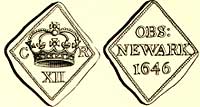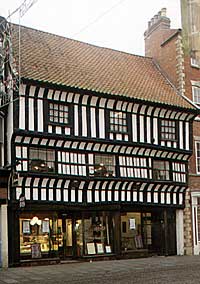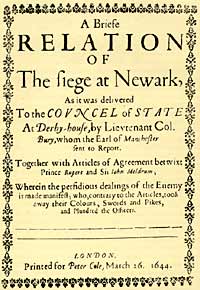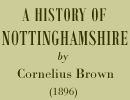< Previous | Contents | Next >

Siege money from the third siege of Newark (Throsby, 1790).
Coming to the times of the Stuarts, the part played by Newark in the Great Rebellion is unique in history. The town was so strongly Royalist, and so well defended, that it was never reduced by the forces of the Parliament. James I. passed through the borough on his way to assume the crown; and on subsequent occasions he appears to have paid the castle a visit, according to the entries in the State Papers. However interesting these evidences of royal favour may have been to the burgesses of the ancient town, they were altogether eclipsed by the events of the next reign. The imposition of ship money pressed heavily upon Newark, and there were other grievances calculated to alienate the feelings of the inhabitants from the King's Government, yet so deeply was the spirit of loyalty and fidelity infused into them, that upon the eve of the war between Charles and his Parliament, the King repaired to Newark, not (said he) 'to inspire their devotion, but only to confirm it.'
In the summer of 1642 the town was garrisoned under Governor Henderson, earthworks were thrown up, and arms and ammunition collected. The next winter the Marquis of Newcastle arrived, and preparations were completed to repel an onslaught of the enemy. Two troops of cavalry attempted by stealth to capture the town, but were easily repulsed. Early in 1643 soldiers from Derby and Nottingham, under Sir John Gell and Colonel Hutchinson, assailed the town on one side, while forces from Lincolnshire besieged it on the other. A sharp struggle ensued, but the garrison succeeded in withstanding all assaults. In June, 1643, the Queen, accompanied by General Cavendish, passed through the town, and in a letter from her to the King, dated Newark, July 27, she states that the army with her consisted of no less than 3,000 foot, thirty companies of horse, and six pieces of cannon.

The Governor's House on Stodman Street dates from the late 15th century. Sir John Henderson and his successors, Sir Richard Byron, Sir Richard Willis and Lord Bellasis are reputed to have resided here during the war. (A. Nicholson, 2000).
The daring of the garrison was such that, having repulsed the attacking parties of the Parliament, they gallantly endeavoured to make reprisals upon the forces under Colonel Hutchinson at Nottingham. The Parliamentarians therefore determined to make a grand assault upon the place in order to reduce it. In February, 1644, about 8,500 men under Sir John Meldrum, with a powerful train of artillery, assembled in front of Newark. An intimation of this movement on the part of the enemy was conveyed to the gallant Prince Rupert, who hurried to the relief of the suffering garrison. Drawing up his men at Coddington, he charged down Beacon Hill with his accustomed impetuosity, and with a shout ' For God and for the King,' carried all before him. The courageous action of the Prince and the equally vigorous efforts of the garrison proved more than Sir John Meldrum could withstand, and after three weeks' siege Newark was happily and successfully relieved.
Messages of congratulation poured in from Cavaliers in all parts of the country, and the King, in a letter to the Corporation, which is copied in the old minute-book, said he had a greater sense of their merit than he could possibly express.
Another assault upon the garrison took place early in 1645, when it was relieved by Sir Marmaduke Langdale. When not defending the town, the Newark horse were formidable in attack, and in the famous Battle of Naseby they bore a gallant part. After that disastrous day, it was to Newark that many of the dusty troopers rode for succour and encouragement, and upon the loss of Bristol it was to the famous 'Key of the North' that Prince Rupert hurried to give an account to the King of the surrender of that town. A stormy scene occurred, in which his Majesty reproached, his royal nephews Rupert and Maurice for their conduct, and the two Princes, calling for their horses, marched sadly away, the King looking out of a window and weeping to see them as they went.

Sir John Meldrum was forced to surrender to Prince Rupert: this Parliamentarian pamphlet bitterly reported the events: "the perfidious dealings of the Enemy is made manifest, who, contrary to the Articles, took away their Colours, Swords and Pikes, and Plundered the Officers.
Sir Richard Willis, the Governor, who had not been popular with the garrison, was removed from his command, and the Lord Bellasis appointed in his stead. Under his direction the town was strongly fortified, and prepared to resist a third siege—the severest and most desperate of all. The King retired from Newark on November 3, 1645, and soon after the town became invested by the Scotch and English forces.
The Scotch lay at Kelham, a village just outside Newark. General Poyntz, Colonel Roseter, Colonel T. Gray, and Colonel Henry Gray were at other villages in the neighbourhood; but still there was' no idea on the part of the garrison of surrendering, until the King, who had opened up communication with the Scotch commissioners, sent an order to Bellasis to give up the town.
The garrison marched out with the honours of war, and a few days afterwards gangs of men reduced the noble castle to ruins, leaving nothing but the front wall, part of the tower, and the remains of a very fine gatehouse. Of the earthworks, the Queen's Sconce on the Farudon Road is still a magnificent remnant of that style of fortification, and the site is now used for fetes and holiday gatherings.
The town was first incorporated in the reign of Edward VI. (1549), when the chief dignitary was called the Alderman. A new charter was granted by Charles I. in 1625, since which time a Mayor has been elected every year. In 1661 the borough sent two representatives to the first Parliament of Charles II., and continued to do so till the last Redistribution Act, when this privilege was taken away and Newark was made the centre of a Parliamentary division returning one member.
About the time of the Reform Bill, the town was the scene of some exciting Parliamentary contests. Mr. Gladstone in 1832 found his first seat in Parliament as representative for Newark, nominated by the Tory Duke of Newcastle, who wielded at the time great political influence in the borough. His opponent was Serjeant Wilde, afterwards Baron Truro, Lord Chancellor of England. Another candidate for Newark, who rose to be Lord Chancellor, was Mr. Thesiger, and the contest between him and Serjeant Wilde in 1839, when the latter was made Solicitor-General, is one of the most memorable in the electioneering history of Newark. Serjeant Wilde was returned by the small majority of nine votes, and the event has ever since been known as the 'number nine election.
